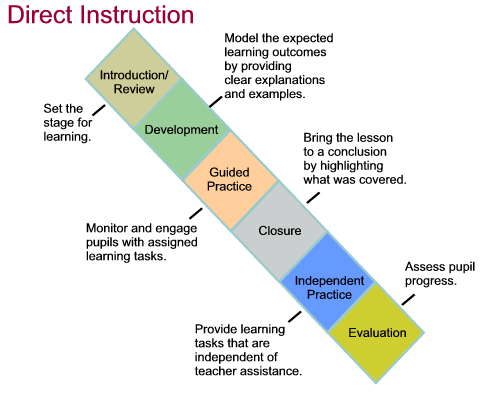All About Classroom Instruction
During class this week we are preparing our lessons and we spent a lot of time discussing the three different types of instruction that are used in the class room. These three types of instruction are listed below.
Direct Instruction
The Direct instruction strategy is highly teacher-directed and is among the most commonly used. This strategy is effective for providing information or developing step-by-step skills. It also works well for introducing other teaching methods, or actively involving students in knowledge construction.
Below is a model of direct Instruction broken down.

Indirect Instruction
In contrast to the direct instruction strategy, indirect instruction is mainly student-centered, although the two strategies can complement each other.
Indirect instruction seeks a high level of student involvement in observing, investigating, drawing inferences from data, or forming hypotheses. It takes advantage of students' interest and curiosity, often encouraging them to generate alternatives or solve problems.
In indirect instruction, the role of the teacher shifts from lecturer/director to that of facilitator, supporter, and resource person. The teacher arranges the learning environment, provides opportunity for student involvement, and, when appropriate, provides feedback to students while they conduct the inquiry (Martin, 1983).
Below is a model of direct Instruction broken down.

Cooperative Learning
Cooperative learning may be broadly defined as any classroom learning situation in which students of all levels of performance work together in structured groups toward a shared or common goal.
According to Johnson, Johnson and Holubc, (1994): "Cooperative learning is the instructional use of small groups through which students work together to maximize their own and each others learning. " In classrooms where collaboration is practiced, students pursue learning in groups of varying size: negotiating, initiating, planning and evaluating together. Rather than working as individuals in competition with every other individual in the classroom, students are given the responsibility of creating a learning community where all students Participate in significant and meaningful ways. Cooperative learning requires that students work together to achieve goals which they could not achieve individually.
Below is a model of direct Instruction broken down.

No comments:
Post a Comment